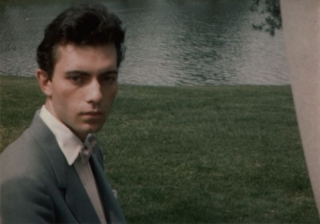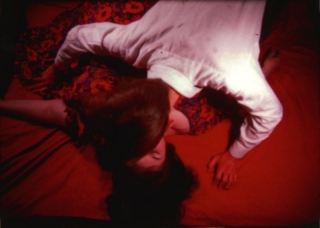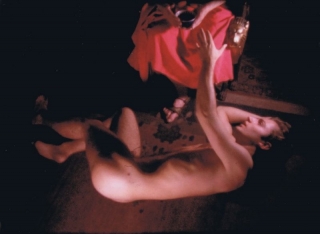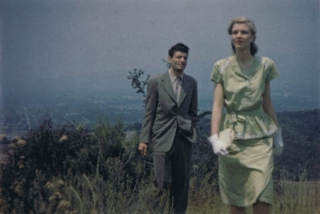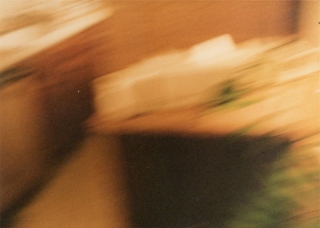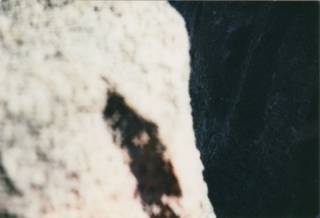Date: 24 November 2014 | Season: Gregory Markopoulos: Film as Film | Tags: Gregory Markopoulos
EARLY WORK
Monday 24 November 2014, at 6pm
Vienna Austrian Filmmuseum
In the presence of Robert Beavers
Gregory J. Markopoulos, A Christmas Carol, 1940, 5 min
Gregory J. Markopoulos, Christmas USA, 1949, 13 min
Gregory J. Markopoulos, The Dead Ones, 1949, 29 min
Gregory J. Markopoulos, Flowers of Asphalt, 1949-51, 7 min
Gregory J. Markopoulos & Robert C. Freeman, Swain, 1950, 20 min
Seinen ersten Film A Christmas Carol dreht er im Alter von zwölf. Mit The Dead Onesund Flowers of Asphalt begibt er sich auf die Spuren Cocteaus. Er liebt Stroheim, studiert bei Sternberg und schreibt, Jahre später, eine huldigende Botschaft an D.W. Griffith, seinen Wahlverwandten. Er glaubt jedoch, dass im Tonfilm der Ton das Bild zu ersticken droht und der Ton selbst nur der naturalistische Schatten des Bildes ist. Sein Traum von der Errettung des Bildes und Befreiung des Tons im Film lässt ihn ein Film-Universum aus Einzelbildern und Tonauslöschungen entwerfen. „Meine Liebe zum Film ist stärker als jede Moral.” Er ist ein Einsamer und einer der Wenigen. Er ist einer der free radicals des Films. (Harry Tomicek)
Date: 6 January 2015 | Season: Gregory Markopoulos: Film as Film | Tags: Gregory Markopoulos
THE ILLIAC PASSION
Tuesday 6 January 2015, at 9:15pm
Amsterdam EYE Filmmuseum
Throughout his life, Markopoulos remained closely connected to his heritage and made many works that connected with ancient Greek culture. The Illiac Passion, one of his most highly acclaimed films, is a visionary interpretation of ‘Prometheus Bound’ starring mythical beings from the 1960s underground. The cast includes Jack Smith, Taylor Mead, Beverly Grant, Gregory Battcock and Gerard Malanga, and Andy Warhol appears as Poseidon riding an exercycle, The extraordinary soundtrack of this re-imagining of the classical realm features a fractured reading of Henry Thoreau’s translation of the Aeschylus text and excerpts from Bartók’s Cantata Profana. Writing about this erotic odyssey, Markopoulos asserted that “the players become but the molecules of the nude protagonist, gyrating and struggling, all in love, bound and unbound, from situation to situation in the vast sea of emotion.”
Gregory J. Markopoulos, The Illiac Passion, 1964-67, USA, 16mm, colour, sound 91 min
“Metamorphosis of the filmmaker. Passions of the filmmaker. Out of his breast the free flowing blood of the creation of a motion picture which depicts the passions of mankind and of everyman in general. The filmmaker selecting and offering to his actors the inheritance of themselves, transforming them through themselves, their own life’s scenario, onto the motion picture screen. A screen in which everything is both transfixed and changed. Not only the filmmaker undergoes changes, i.e. the creative endeavour, but his actors or non-actors, and everyone who associates himself with the very moments during which the filmmaker is working. In this case the greatest alteration taking place towards the film spectator. The new film spectator of the new cinema.” (Gregory J. Markopoulos, 1967)
Introduced by Mark Webber.
Date: 30 January 2015 | Season: Gregory Markopoulos: Film as Film | Tags: Gregory Markopoulos
FILM AS FILM: LAS PELÍCULAS DE GREGORY J. MARKOPOULOS
3—20 February 2015
Spanish touring programme
“There is no language. There is no art. There is no knowledge. There is but film as film: the beginning and the eternal moment.” (The Intuition Space, 1973)
Gregory J. Markopoulos (1928-92) was one of the most original filmmakers to emerge in post-war American cinema. His films, which often translated literary or mythological sources to a contemporary context, are celebrated for their extraordinary creativity, the sensuous use of colour and innovations in cinematic form. A contemporary of Maya Deren, Kenneth Anger and Jonas Mekas, Markopoulos was amongst those at the forefront of a generation that liberated cinema by developing new modes of expression. Having made his first 16mm film (Psyche) in 1947, as a student at USC, he went on to produce several key works of the avant-garde such as Twice a Man (1963) and The Illiac Passion (1964-67).
At the end of the 1960s, he moved to Europe to pursue a very individual path, withdrawing his films from distribution and making them almost impossible to see. Firmly believing that a filmmaker should be responsible for all aspects of his work, he conceived the Temenos, a monographic archive for the presentation, preservation and study of his films. Late in life he chose to re-edit his entire oeuvre into a monumental 80-hour long film to be shown only at a remote location near to his ancestral home in Greece. This speculative project is being realised posthumously by an open-air screening event that has taken place every four years since 2004.
Markopoulos’ films encompass mythic themes, portraiture and studies of landscape and architecture. By employing complex editing techniques and spontaneous in-camera superimposition, he sought to unlock the mystery and energy contained within the single frame. This rare opportunity to experience the work of a true pioneer of independent filmmaking celebrates the publication of Film as Film: The Collected Writings of Gregory J. Markopoulos.
—Mark Webber
Presented in collaboration with Revista Lumière and The Visible Press, with thanks to Robert Beavers and Temenos.
Film as Film 1: Du Sang, de la volupté et de la Mort
Gregory J. Markopoulos, Psyche, 1947, USA, 16mm, colour, sound, 24 min
Gregory J. Markopoulos, Lysis, 1948, USA, 16mm, colour, sound, 25 min
Gregory J. Markopoulos, Charmides, 1948, USA, 16mm, colour, sound, 11min
Tuesday 3 February 2015 at Barcelona Filmoteca de Catalunya – Introduced by Mark Webber
Saturday 7 February 2015 at Madrid La Casa Encendida – Introduced by Mark Webber
Wednesday 18 February 2015 at A Coruña CGAI
Film as Film 2: Gammelion
Gregory J. Markopoulos, Bliss, 1967, Greece, 16mm, colour, sound, 6 min
Gregory J. Markopoulos, Gammelion, 1968, Italy, 16mm, colour, sound, 54 min
Wednesday 4 February 2015 at Barcelona Filmoteca de Catalunya – Introduced by Mark Webber
Sunday 8 February 2015 at Madrid La Casa Encendida – Introduced by Mark Webber
Thursday 19 February 2015 at A Coruña CGAI – Introduced by Mark Webber
Film as Film 3: Portraits
Gregory J. Markopoulos, Through a Lens Brightly: Mark Turbyfill, 1967, USA, 16mm, colour, sound, 14 min
Gregory J. Markopoulos, Political Portraits, 1969, Switzerland, 16mm, colour, silent, 12 min (excerpt)
Gregory J. Markopoulos, The Olympian, 1969, Italy, 16mm, colour, silent, 23 min
Gregory J. Markopoulos, Gilbert and George, 1975, France, 16mm, colour, silent, 12 min
Thursday 5 February 2015 at Barcelona Filmoteca de Catalunya – Introduced by Mark Webber
Monday 9 February 2015 at Madrid Museo Reina Sofia – Introduced by Arnau Vilaró
Friday 20 February 2015 at A Coruña CGAI – Introduced by Mark Webber
Film as Film 4: The Illiac Passion
Gregory J. Markopoulos, The Illiac Passion, 1964-67, USA, 16mm, colour, sound, 91 min
Sunday 8 February 2015 at Barcelona CCCB Xcentric – Introduced by Revista Lumière
Tuesday 10 February 2015 at Madrid Museo Reina Sofia
Friday 20 February 2015 at A Coruña CGAI
Date: 22 March 2015 | Season: Gregory Markopoulos: Film as Film | Tags: Gregory Markopoulos
THE ILLIAC PASSION
Sunday 22 March 2015, at 7:30pm
Los Angeles Filmforum
Throughout his life, Markopoulos remained closely connected to his heritage and made many works that connected with ancient Greek culture. The Illiac Passion, one of his most highly acclaimed films, is a visionary interpretation of ‘Prometheus Bound’ starring mythical beings from the 1960s underground. The cast includes Jack Smith, Taylor Mead, Beverly Grant, Gregory Battcock and Gerard Malanga, and Andy Warhol appears as Poseidon riding an exercise bike. The extraordinary soundtrack of this re-imagining of the classical realm features a fractured reading (by the filmmaker) of Henry Thoreau’s translation of the Aeschylus text and excerpts from Bartók’s Cantata Profana. Writing about this erotic odyssey, Markopoulos asserted that, “the players become but the molecules of the nude protagonist, gyrating and struggling, all in love, bound and unbound, from situation to situation in the vast sea of emotion.”
Gregory J. Markopoulos, The Illiac Passion, 1964-67, USA, 16mm, color, sound, 91 min
PROGRAMME NOTES
THE ILLIAC PASSION
Sunday 22 March 2015, at 7:30pm
Los Angeles Filmforum
THE ILLIAC PASSION
Gregory J. Markopoulos, USA, 1964-67, 16mm, sound, colour, 92 minutes
“Metamorphosis of the filmmaker. Passions of the filmmaker. Out of his breast the free flowing blood of the creation of a motion picture which depicts the passions of mankind and of everyman in general. The filmmaker selecting and offering to his actors the inheritance of themselves, transforming them through themselves, their own life’s scenario, onto the motion picture screen. A screen in which everything is both transfixed and changed. Not only the filmmaker undergoes changes, i.e. the creative endeavor, but his actors or non-actors, and everyone who associates himself with the very moments during which the filmmaker is working. In this case the greatest alteration taking place towards the film spectator. The new film spectator of the new cinema. […]
“Set afire, the soul of the film spectator and the mythic characters or real personalities of The Illiac Passion commence to alternate, sometimes obliterate and then return to a moment passed or forgotten. That moment taking on greater meaning (upon its return, second return or reference in the film – via single frames, clusters of frames, and the classic principles of film editing), the symbols, the individual psychology united in a single structure, i.e. The Illiac Passion. All revealing the same story, but in variation, all united, all invoking the passions, and all seen through the vibrant passion of the hero, Mr Richard Beauvais as the apotheosis of a Prometheus who is not to bound to a rock, but bound to his own passions; i.e. his own life’s scenario. And, all the various myths which the filmmaker uses in this development in The Illiac Passion become involved in that time development known as eternity.” (Gregory J. Markopoulos, The Illiac Passion, 1967)
Back to top
Date: 12 April 2015 | Season: Gregory Markopoulos: Film as Film | Tags: Gregory Markopoulos
GREGORY J. MARKOPOULOS: EARLY FILMS OF THE 40S & 50S
Sunday 12 April 2015, at 7:30pm
Los Angeles Filmforum
Having made 8mm films as a child, Markopoulos sought to advance his knowledge of filmmaking by enrolling at the USC Film School, where he attended lectures by Joseph von Sternberg and observed productions of Fritz Lang, Alfred Hitchcock and Alexander Korda. His first 16mm film, Psyche, was made in Los Angeles at this time, concurrent with the first films by Curtis Harrington and Kenneth Anger. Abandoning his studies after only three semesters, he returned to his hometown of Toledo, Ohio, and completed some half dozen films. These early works often explore themes of sexual awakening and the anxiety of coming to terms with homosexuality in an age of repression. In the mid-1950s, the filmmaker embarked on the ill-fated feature Serenity in Greece before re-emerging with Twice a Man (1963), the work that secured Markopoulos’ position as one of independent cinema’s leading figures.
Gregory J. Markopoulos, Psyche, 1947, 24 min
Gregory J. Markopoulos, Christmas-USA-1949, 1950, 13 min
Gregory J. Markopoulos, Eldora, 1953, 11 min
Gregory J. Markopoulos & Robert C. Freeman, Swain, 1950, 20 min
PROGRAMME NOTES
GREGORY J. MARKOPOULOS: EARLY FILMS OF THE 40S & 50S
Sunday 24 May 2015
Zurich Videoex Festival
PSYCHE
Gregory J. Markopoulos, 1947, USA, 16mm, color, sound, 24 min
Psyche, which takes as its source an unfinished novella of the same name by Pierre Louÿs, is a remarkably ambitious and sensual work for a 19-year old to have made in the late 1940s – addressing themes of eros and lesbianism, and containing sequences of montage that presage the techniques of rapid editing that advance in later works. Psyche can stand alone, but was also shown together with Lysis and Charmides (both made in Toledo the following year, inspired by Platonic dialogues) in the trilogy Du sang de la volupte et de la mort (1947-48).
“The first thing which I did was to delete the novelette of its lush rhetoric and retain only its symbolic color. In Psyche, color plays an important role, similar to the role which color plays in the paintings of Toulouse Lautrec. Color reflects the true character of the individual before us, whether it be on the screen, in a painting, or in the street. Color is Eros.” (Gregory J. Markopoulos, Psyche’s Search for the Herb of Invulnerability, 1955)
CHRISTMAS-USA-1949
Gregory J. Markopoulos, 1950, USA, 16mm, b/w, sound, 13 min
Having abandoned his studies at USC, Markopoulos returned to Ohio and completed some half dozen films before shooting the feature film Serenity in Greece. Christmas-USA-1949 (aka Christmas USA) weaves together documentary and fiction to convey a moment of awakening, and was shot at the ‘Cavalcade of Amusements’ travelling fairground, and in the Markopoulos family home and local surrounds.” Its closing credits declare “the end of a period.”
ELDORA
Gregory J. Markopoulos, 1953, USA, 16mm, color, silent, 11 min
“The dreamlike Eldora describes love’s fragmenting effects on the consciousness of an adolescent girl.” (Kristin M. Jones). Eldora was shot on 8mm stock given to the filmmaker by the LA-based exhibitor and collector Raymond Rohauer, and is dedicated to Robert C. Freeman, his collaborator on Swain. In his writings, Markopoulos refers to the film’s “cautious and excruciatingly slow movement” and describes its heroine “proceeding as if with lunar strides across the wet, soft, earthly shore matter of the Maumee River.”
SWAIN
Gregory J. Markopoulos & Robert C. Freeman, 1950, USA, 16mm, color, sound, 20 min
“An exquisite early psychodramatic trance film reminiscent of Maya Deren’s films, Swain is loosely inspired by Nathaniel Hawthorne’s Fanshawe and is rich in metaphor. Starring Markopoulos, Swain is an evocation in gentle images and visual symbols of a subconscious rejection of the stereotyped masculine role that both society and women insist upon. This rejection takes the form of escape – a flight in fantasy from what is visually perceived as crude, repelling sexuality into the purity of creative activity, of nature, and of the individual personality left inviolate.” (Donald Weinstein, Swain: Flowers and Flight, 1963)
Back to top
Date: 23 May 2015 | Season: Gregory Markopoulos: Film as Film | Tags: Gregory Markopoulos
THE ILLIAC PASSION
Saturday 23 May 2015, at 8:15pm
Zurich Videoex Festival
Throughout his life, Markopoulos remained closely connected to his heritage and made many works that connected with ancient Greek culture. The Illiac Passion, one of his most highly acclaimed films, is a visionary interpretation of ‘Prometheus Bound’ starring mythical beings from the 1960s underground. The cast includes Jack Smith, Taylor Mead, Beverly Grant, Gregory Battcock and Gerard Malanga, and Andy Warhol appears as Poseidon riding an exercise bike. The extraordinary soundtrack of this re-imagining of the classical realm features a fractured reading (by the filmmaker) of Henry Thoreau’s translation of the Aeschylus text and excerpts from Bartók’s Cantata Profana. Writing about this erotic odyssey, Markopoulos asserted that, “the players become but the molecules of the nude protagonist, gyrating and struggling, all in love, bound and unbound, from situation to situation in the vast sea of emotion.”
Gregory J. Markopoulos, The Illiac Passion, 1964-67, USA, 16mm, colour, sound, 91 min
PROGRAMME NOTES
THE ILLIAC PASSION
Saturday 23 May 2015
Zurich Videoex Festival
THE ILLIAC PASSION
Gregory J. Markopoulos, USA, 1964-67, 16mm, sound, colour, 91 minutes
“Metamorphosis of the filmmaker. Passions of the filmmaker. Out of his breast the free flowing blood of the creation of a motion picture which depicts the passions of mankind and of everyman in general. The filmmaker selecting and offering to his actors the inheritance of themselves, transforming them through themselves, their own life’s scenario, onto the motion picture screen. A screen in which everything is both transfixed and changed. Not only the filmmaker undergoes changes, i.e. the creative endeavor, but his actors or non-actors, and everyone who associates himself with the very moments during which the filmmaker is working. In this case the greatest alteration taking place towards the film spectator. The new film spectator of the new cinema. […]
“Set afire, the soul of the film spectator and the mythic characters or real personalities of The Illiac Passion commence to alternate, sometimes obliterate and then return to a moment passed or forgotten. That moment taking on greater meaning (upon its return, second return or reference in the film – via single frames, clusters of frames, and the classic principles of film editing), the symbols, the individual psychology united in a single structure, i.e. The Illiac Passion. All revealing the same story, but in variation, all united, all invoking the passions, and all seen through the vibrant passion of the hero, Mr Richard Beauvais as the apotheosis of a Prometheus who is not to bound to a rock, but bound to his own passions; i.e. his own life’s scenario. And, all the various myths which the filmmaker uses in this development in The Illiac Passion become involved in that time development known as eternity.”
(Gregory J. Markopoulos, The Illiac Passion, 1967)
Back to top
Date: 24 May 2015 | Season: Gregory Markopoulos: Film as Film | Tags: Gregory Markopoulos
GREGORY J. MARKOPOULOS: EARLY FILMS OF THE 40s & 50s
Sunday 24 May 2015, at 6:30pm
Zurich Videoex Festival
Having made 8mm films as a child, Markopoulos sought to advance his knowledge of filmmaking by enrolling at the USC Film School, where he attended lectures by Joseph von Sternberg and observed productions of Fritz Lang, Alfred Hitchcock and Alexander Korda. His first 16mm film, Psyche, was made in Los Angeles at this time, concurrent with the first films by Curtis Harrington and Kenneth Anger. Abandoning his studies after only three semesters, he returned to his hometown of Toledo, Ohio, and completed some half dozen films. These early works often explore themes of sexual awakening and the anxiety of coming to terms with homosexuality in an age of repression. In the mid-1950s, the filmmaker embarked on the ill-fated feature Serenity in Greece before re-emerging with Twice a Man (1963), the work that secured Markopoulos’ position as one of independent cinema’s leading figures.
Gregory J. Markopoulos, Psyche, 1947, 24 min
Gregory J. Markopoulos, Christmas-USA-1949, 1950, 13 min
Gregory J. Markopoulos, Eldora, 1953, 11 min
Gregory J. Markopoulos & Robert C. Freeman, Swain, 1950, 20 min
PROGRAMME NOTES
GREGORY J. MARKOPOULOS: EARLY FILMS OF THE 40s & 50s
Sunday 24 May 2015
Zurich Videoex Festival
PSYCHE
Gregory J. Markopoulos, 1947, USA, 16mm, color, sound, 24 min
Psyche, which takes as its source an unfinished novella of the same name by Pierre Louÿs, is a remarkably ambitious and sensual work for a 19-year old to have made in the late 1940s – addressing themes of eros and lesbianism, and containing sequences of montage that presage the techniques of rapid editing that advance in later works. Psyche can stand alone, but was also shown together with Lysis and Charmides (both made in Toledo the following year, inspired by Platonic dialogues) in the trilogy Du sang de la volupte et de la mort (1947-48).
“The first thing which I did was to delete the novelette of its lush rhetoric and retain only its symbolic color. In Psyche, color plays an important role, similar to the role which color plays in the paintings of Toulouse Lautrec. Color reflects the true character of the individual before us, whether it be on the screen, in a painting, or in the street. Color is Eros.” (Gregory J. Markopoulos, Psyche’s Search for the Herb of Invulnerability, 1955)
CHRISTMAS-USA-1949
Gregory J. Markopoulos, 1950, USA, 16mm, b/w, sound, 13 min
Having abandoned his studies at USC, Markopoulos returned to Ohio and completed some half dozen films before shooting the feature film Serenity in Greece. Christmas-USA-1949 (aka Christmas USA) weaves together documentary and fiction to convey a moment of awakening, and was shot at the ‘Cavalcade of Amusements’ travelling fairground, and in the Markopoulos family home and local surrounds.” Its closing credits declare “the end of a period.”
ELDORA
Gregory J. Markopoulos, 1953, USA, 16mm, color, silent, 11 min
“The dreamlike Eldora describes love’s fragmenting effects on the consciousness of an adolescent girl.” (Kristin M. Jones). Eldora was shot on 8mm stock given to the filmmaker by the LA-based exhibitor and collector Raymond Rohauer, and is dedicated to Robert C. Freeman, his collaborator on Swain. In his writings, Markopoulos refers to the film’s “cautious and excruciatingly slow movement” and describes its heroine “proceeding as if with lunar strides across the wet, soft, earthly shore matter of the Maumee River.”
SWAIN
Gregory J. Markopoulos & Robert C. Freeman, 1950, USA, 16mm, color, sound, 20 min
“An exquisite early psychodramatic trance film reminiscent of Maya Deren’s films, Swain is loosely inspired by Nathaniel Hawthorne’s Fanshawe and is rich in metaphor. Starring Markopoulos, Swain is an evocation in gentle images and visual symbols of a subconscious rejection of the stereotyped masculine role that both society and women insist upon. This rejection takes the form of escape – a flight in fantasy from what is visually perceived as crude, repelling sexuality into the purity of creative activity, of nature, and of the individual personality left inviolate.” (Donald Weinstein, Swain: Flowers and Flight, 1963)
Back to top
Date: 25 October 2015 | Season: Gregory Markopoulos: Film as Film | Tags: Gregory Markopoulos
GREGORY J. MARKOPOULOS
Sunday 25 October 2015, at 3:45pm
Lisbon Doclisboa at Culturgest
Figura ímpar na história do cinema, Markopoulos abandonou os Estados Unidos, depois de ter sido uma das figuras cimeiras do New American Cinema, vindo, inclusivamente, a retirar os seus filmes de circulação. Na última década da sua vida, dedicou-se a rever e a reeditar os seus filmes desde finais dos anos 1940, num projecto de 80 horas, Eniaios (palavra grega, significan- do “carácter único” e “unidade”), ciclo que, enquanto tal, e como um ritual, se destina a ser visto cada quatro anos, num sítio único, Temenos.
Gregory J. Markopoulos, Gilbert and George (ENIAIOS III – Reel 1), 1975/1989-91, 12 min
Markopoulos retratou artistas como Moravia, Nureyev ou De Chirico. Este retrato da dupla Gilbert & George é marcado pela ausência da imagem interrompida por fragmentos dos corpos destas duas esculturas vivas, e pela ausência de movimento.
Gregory J. Markopoulos, Genius (ENIAIOS – Reels 2, 3, 4), 1970/1989-91, 80 min
Um retrato triplo, inspirado na lenda de Fausto, do artista britânico David Hockney, do pintor surrealista argentino Leonor Fini e do comerciante de arte Daniel-Henry Kahnweiler. Com uma estrutura calculada, Genius constitui a secção central de Eniaios III.
Projecção precedida da apresentação do livro Film as Film: The Collected Writings of Gregory J. Markopoulos, organizado por Mark Webber, com um prefácio de P. Adams Sitney e publicado por The Visible Press (2014).
Date: 20 May 2016 | Season: Peter Gidal: Flare Out
PETER GIDAL: CLOSE UP
Friday 20 May 2016, at 7:30pm
London Close-Up Film Centre
Peter Gidal and Mark Webber will introduce a screening of Gidal’s ‘feature length’ film Close Up (1983) to coincide with the publication of Flare Out: Aesthetics 1966–2016, a collection of essays by one of film’s great polemicists. Gidal was a central figure during the formative years of the London Film-Makers’ Co-operative and made some its most radical works. His cinema is anti-narrative, against representation, and fiercely materialist.
“Close Up is crystal hard, intransigent, and film in extremis. In short, one of the best ‘political’ films made in this country.” —Michael O’Pray, Monthly Film Bulletin
In Close Up, Peter Gidal’s political, ultra-leftist practice is augmented by the disembodied voices of two Nicaraguan revolutionaries heard of the soundtrack. These voices punctuate a film whose representation of a room, an inhabited space, is one in which the viewer must consciously search for recognition, for meaning-making. The image-content is muted and abstract, but fascinating, with moments of (no-doubt) inadvertent beauty.
Presented in association with LUX.
Date: 25 May 2016 | Season: Peter Gidal: Flare Out
PETER GIDAL: FLARE OUT — SCREENING AND BOOK LAUNCH
Wednesday 25 May 2016, at 7pm
Paris Centre Pompidou
For five decades, Peter Gidal has sought to problematise the film-viewing process by creating works that resist recognition and identification. His practice posits film as a durational experience and negates analysis on psychological grounds. This programme, featuring the seminal film Clouds (1969) and later works Flare Out (1992), Volcano (2002) and not far at all (2013), surveys his radical and unique approach.
Peter Gidal, Clouds, 1969, 10 min
Peter Gidal, Flare Out, 1992, 20 min
Peter Gidal, Volcano, 2002, 30 min
Peter Gidal, not far at all, 2013, 15 min
Gidal has been based in the UK since the late 1960s, and was a central figure during the formative years of the London Film-Makers’ Co-operative. He is a noted writer and polemicist, whose “Theory and Definition of Structural/Materialist Film” is a key text of avant-garde cinema. The screening celebrates the publication of Flare Out: Aesthetics 1966–2016, a collection of Gidal’s essays on film, art and aesthetics, and will be introduced by the filmmaker and editor/publisher Mark Webber.
“Mental activation toward material analysis is the process that is relevant, whether or not actual structure is ‘revealed’.” —Peter Gidal, 1969
PROGRAMME NOTES
PETER GIDAL: FLARE OUT — SCREENING AND BOOK LAUNCH
Wednesday 25 May 2016, at 7pm
Paris Centre Pompidou
CLOUDS
Peter Gidal, 1969, 16mm, b/w, sound, 10 min
The anti-illusionist project engaged by Clouds is that of dialectical materialism. There is virtually nothing on screen, in the sense of in screen. Obsessive repetition as materialist practice not psychoanalytical indulgence. (PG)
FLARE OUT
Peter Gidal, 1992, 16mm, colour, sound, 20 min
Sound: unrecognition unidentified, in time, you hear? Image: recognition identified, out of time in time; not not knowing the unknown but not knowing the known, no trace of ‘no trace of any thing’. e.g. grain: is grain silver, black & white, or colour? Is silver black & white or colour? You see? (PG)
VOLCANO
Peter Gidal, 2002, 16mm, b/w & colour, silent, 30 min
The film attempts to deal with those questions of representation that persist as problematic, for me, for the basic questions of aesthetics, what it is to view, how to view the unknown, as to view the known is not possibly a viewing. The question of recognition, the impossibility of recognition or, better said, the impossibility of a viewer viewing at all if it is predicated upon recognition … At that moment, you the viewer I the viewer am no longer part of a process, a material however metaphysical or not process of making meaning through the conflicts of perception of something … In Volcano light’s afterimage, the shot of light after image, becomes as obliterative as dark’s … Thereby the temporal break caused by transparent leader, and by black leader, becomes differently spatial and temporal, as to the “something missing”… (PG)
not far at all
Peter Gidal, 2013, 16mm, colour, sound, 15 minutes
First film in 5 years, tempted to say different yet the same, but not. not far at all’s soundtrack, just for the record, is concrete/abstract without language. (PG)
Back to top
